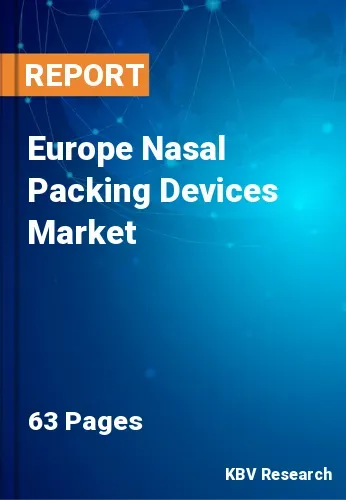The Europe Nasal Packing Devices Market would witness market growth of 4.7% CAGR during the forecast period (2022-2028).
Many children and adults visit primary-care or emergency-department clinicians due to epistaxis, or sudden hemorrhage from the nasal cavity, nostril, or nasopharynx. Patients may be considering therapy for a one-time, small nosebleed, or a chronic, serious occurrence. Epistaxis is classified as either an anterior or a posterior hemorrhage, depending on where the bleeding occurs. Treatment is determined by the clinical picture, the treating provider's experience, and the availability of supplementary services.
It is critical to utilize nasal packing after sinus surgery to assist limit bleeding and provide support to separate structure and tissue at the operative site. Bioresorbable nasal packing helps heal wounds by preventing adhesions between mucosal surfaces. It also avoids the need for harsh nasal packing removal because it degrades gradually and is discharged naturally. Bioresorbable nasal packing devices are available in a variety of sizes, compression strengths, fragmentation times, and hemostatic qualities to offer a comfortable post-operative experience for patients. For optimal support, hemostasis, stability, and also adhesion prevention, a variety of nasal packing compression options are available commercially. Because nasal packing products dissolve, they pass through the mucosal flow naturally.
The population of the United Kingdom has been steadily aging, and this trend is expected to continue in the future. According to the Office of National Statistics, in 2016, 11.8 million people aged 65 and up lived in the UK, accounted for 18% of the overall population. 25 years earlier, 9.1 million people aged 65 and above made up 15.8% of the population. With the same rate, in 2041, the 1960s people (now in their 50s) would be in their geriatric age, and by 2066, there will be an additional 8.6 million UK citizens aged 65 and up, bringing the overall number to 20.4 million and accounting for 26% of the total population. This rise in population is nearly similar to the current population of London.
The group of people aged 85 and above would witness the greatest growth. In mid-2016, there were 1.6 million people aged 85 and up (2% of the total population). By mid-2041, this number is expected to double to 3.2 million (4%), and by 2066, it is expected to triple, with 5.1 million people aged 85 and up accounting for 7% of the total population. In comparison, the population of those aged 16 to 64 is expected to grow by only 2% during the next 25 years, and by 5% by 2066.
The Germany market dominated the Europe Nasal Packing Devices Market by Country in 2021, and would continue to be a dominant market till 2028; thereby, achieving a market value of $15,089.7 Thousands by 2028. The UK market is experiencing a CAGR of 3.8% during (2022 - 2028). Additionally, The France market would exhibit a CAGR of 5.5% during (2022 - 2028).
Based on Product, the market is segmented into Spray, Gel, Injectable, and Dressings. Based on Type, the market is segmented into Non-absorbable and Bio-resorbable. Based on countries, the market is segmented into Germany, UK, France, Russia, Spain, Italy, and Rest of Europe.
Free Valuable Insights: The Global Nasal Packing Devices Market will Hit $240.6 Million by 2028, at a CAGR of 5.4%
The market research report covers the analysis of key stake holders of the market. Key companies profiled in the report include Smith & Nephew PLC, Medtronic PLC, Stryker Corporation, Olympus Corporation, Summit Health, Network Medical Products Ltd., Lohmann & Rauscher GmbH & Co. KG, Meril Life Science Private Limited, First Aid Bandage Company, and Aegis Lifesciences Pvt. Ltd.
By Product
By Type
By Country

Our team of dedicated experts can provide you with attractive expansion opportunities for your business.

